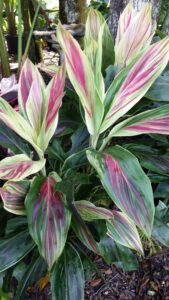S & J Nursery’s Guide to Growing
Compact Cordyline ‘Exotica’
for the Northeast Florida Landscape
Cordyline fruticosa ‘Exotica’ Origins:
– Cordyline fruticosa or Hawaiian Ti plants are members of the Agavaceae family making them relatives of both Agave and Yucca plants. Cordyline fruticosa is from New Guinea and Southeast Asia.
– Cordyline fruticosa ‘Exotica’ is a beautifully variegated foliage plant that has both white and pink variegation in the leaves. Grown for its unique coloration, ‘Exotica’ adds an instant tropical appeal to the landscape. Big bold foliage and beautifully soft coloration that will not overpower surrounding plants or distract from the overall landscape when used in large masses.
Preferred Exposure of the Cordyline Exotica:
– Cordyline fruticosa ‘Exotica’ should only be planted in a full
shade to part shade location in the Northeast Florida / Jacksonville | St. Augustine area landscape. Best or brightest foliage color will be achieved in a shadier garden location.
Foliage of the Cordyline fruticosa Exotica Plant:
– Big bold foliage has a wide leaf blade that is accented with both pink and white variegation. The soft striped pattern makes these plants easily used in large masses for tropical garden settings. Very pretty in the landscape.
– Foliage may remain evergreen during the winter in our Northeast Florida area gardens, but can go dormant and regrow from undamaged stems or from the roots the following spring depending on winter conditions and temperature exposure. Cordyline plants are particularly responsive to their individual planting location. When planted on the south side of the house away from north winds, or where receiving some frost protection form larger trees or nearby buildings, Cordyline plants have been known to remain evergreen in the roughest of winters here in North Florida.
Soil Preference / Salt tolerance of Cordyline Exotica:
– Cordyline plants prefer moist but well draining soils that are rich in organic matter so amend your planting hole generously when planting into our Northeast Florida landscapes.
– Poor salt tolerance.
Size Variance of the Cordyline Exotica Plant:
– Tall growing Hawaiian Ti can reach up to 5 ft high!
Growth Rate:
– Expect this one to reach its full size potential around the second to third
year in the landscape.
Water Requirements:
– Although much more durable once established in the landscape, regular water is necessary to get the plant rooted and growing on it’s own after being planted in the ground from an S & J Nursery container. Water every day for the first week then every other day for the next week, and continue to taper watering black to a minimum of once a week.
– Use supplemental irrigation once to twice a week after the plant is
established and growing in the landscape especially during the hot summer months. Cordyline plants have a tendency to experience damage to the foliage during prolonged exposure to drought.
Best Use for the Cordyline fruticosa ‘Exotica’ Plant in the Jacksonville | St.
Augustine Florida Area Landscapes :
– The soft but colorful foliage make Cordyline Exotica perfect for mixing
among other flowering plants in the perennial border or container planting. Unlike some of the brighter colored Hawaiian Ti plants that can become overpowering when planted in large masses, the soft pink and white coloration, makes the Exotica the perfect fit for mass plantings to create a tropical garden setting.
– Beautiful when planted in groupings around a palm tree, bird bath,
fountain or other garden accents.
– Easy care plant for containers on pool decks, patio areas, walkways, home
entry accents etc.
– Great indoor planting.
Care of Compact Cordyline fruticosa ‘ Exotica ‘ in the Northeast Florida
Landscape:
– Amend the soil generously with compost at planting time to ensure that the plant will have moist but well draining soils.
– If planting Cordyline into flood prone areas or areas that hold
water after heavy rains, be sure to plant them into an elevated mound of soil to let the roots get air during storm season. Just 4-6 inches above grade can keep your plants beautiful in these areas instead of watching them suffer.
– Water every day during the establishment period after planting in the garden from an S & J Nursery container.
-Trim off cold damaged foliage in spring after all danger of frost has passed.
Fertilize with a slow release garden food like Osmocote directly after spring pruning and again in summer.

